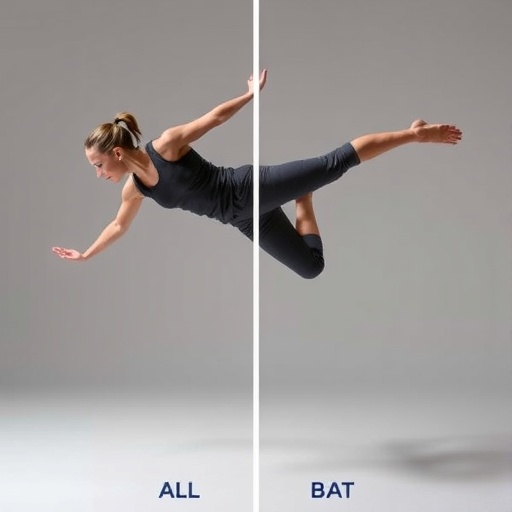In a significant exploration of postural control in adults, a recent study highlights the critical differences between individuals with and without a fear of falling. This research, conducted by Sung and Lee, sheds light on a pivotal aspect of geriatric health that affects mobility, balance, and overall quality of life. The findings of this study could revolutionize the approaches employed in rehabilitation programs and fall prevention strategies, emphasizing the imperative connection between psychological factors and physical stability.
Postural control is a complex process that involves the integration of sensory information, cognitive functions, and motor responses. It plays a crucial role in maintaining balance, especially as individuals age. The study by Sung and Lee systematically evaluates how fear — particularly fear of falling — alters postural control mechanisms, potentially leading to a cycle that exacerbates vulnerability to falls. This research is especially timely as the aging population grows, presenting challenges in health care and social services regarding mobility-related health issues.
The implications of a fear of falling extend beyond mere anxiety; they can lead to significant changes in behavior. Individuals who harbor this fear may unconsciously limit their physical activities, leading to decreased muscle strength and proprioception. Consequently, a decline in physical capabilities can further enhance their fear, creating a vicious cycle that is incredibly difficult for older adults to escape. Sung and Lee’s research emphasizes the need to understand this cycle and develop interventions that address both the physical and psychological components of postural control.
This comparative analysis involved a diverse sample of participants, ensuring that the findings are robust and applicable across various demographics. By analyzing the dominant limb’s postural control, the researchers were able to draw specific conclusions about how fear influences balance. This approach sheds light not only on the physical mechanics of alignment and movement but also on the emotional and cognitive underpinnings that govern these responses.
Furthermore, the intricacies of postural stability were examined through a series of standardized tests that assess lateral stability, forward stability, and overall body control. These tests reveal how fear impacts the biomechanical strategies employed during standing and walking. Notably, individuals with a heightened fear of falling exhibited more significant deviations from optimal postural control strategies, which directly correlated with their perceived levels of anxiety and apprehension.
The findings underscore the importance of addressing psychological factors alongside physical rehabilitation. For practitioners, this means integrating fear management techniques within physical therapy and rehabilitation settings. Cognitive behavioral strategies, resilience training, and systematic desensitization could be pivotal in equipping individuals with the tools they need to confront and reduce their fear of falling.
Moreover, this research opens the door to further inquiries into how tailored interventions can enhance the quality of life for older adults. By identifying at-risk populations through assessments of psychological factors, healthcare providers can implement preventive measures that are more effective and individualized. This proactive approach can significantly reduce incidents of falls, thereby lowering healthcare costs and enhancing the well-being of an aging population.
In conclusion, the comparative analysis conducted by Sung and Lee presents critical insights into the nexus between psychological factors and postural control. With the study’s compelling evidence, there is a pressing need for healthcare professionals to adopt a multidisciplinary stance in understanding and treating the challenges faced by older adults. By recognizing the intertwining roles of fear, physical capability, and balance, we can foster rehabilitation strategies that empower individuals, cultivate confidence, and ultimately enhance mobility and independence in their daily lives.
The study not only provides a foundation for understanding the mechanics of fear-related postural instability but also serves as a call to action for future research initiatives. The integration of psychological assessments into physical rehabilitation will hopefully gain traction, paving the way for a more holistic approach to geriatric health.
As we navigate the complexities of aging, it is crucial to recognize the powerful interplay between mind and body. Future studies dedicated to unraveling this relationship will undeniably contribute to the development of comprehensive frameworks geared towards promoting the health and safety of our aging population. Sung and Lee have successfully illuminated this path, and it is now our collective responsibility to follow through on these insights with tangible actions and interventions that prioritize both physical and psychological health.
Ultimately, this research could inspire a paradigm shift in how we perceive aging, mobility, and psychological well-being, advocating for a more integrated approach to health care. Such changes could alleviate the burdens often associated with aging and reaffirm the dignity and independence of older adults, allowing them to thrive rather than merely survive.
As the dialogue surrounding geriatric health continues to evolve, studies like that of Sung and Lee will undoubtedly play a pivotal role in shaping the future of fall prevention and rehabilitation strategies — a future where individuals are empowered to defy stereotypes of aging, equipped with the tools and support that foster both balance and confidence.
Subject of Research: Comparative analysis of postural control in relation to fear of falling in adults.
Article Title: Comparative analysis of dominant limb postural control in adults with and without fear of falling.
Article References:
Sung, P.S., Lee, D. Comparative analysis of dominant limb postural control in adults with and without fear of falling.
BMC Geriatr 25, 683 (2025). https://doi.org/10.1186/s12877-025-06258-0
Image Credits: AI Generated
DOI: 10.1186/s12877-025-06258-0
Keywords: postural control, fear of falling, aging, physical rehabilitation, psychological factors, balance, geriatric health.




